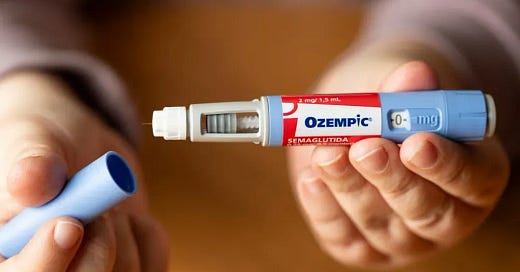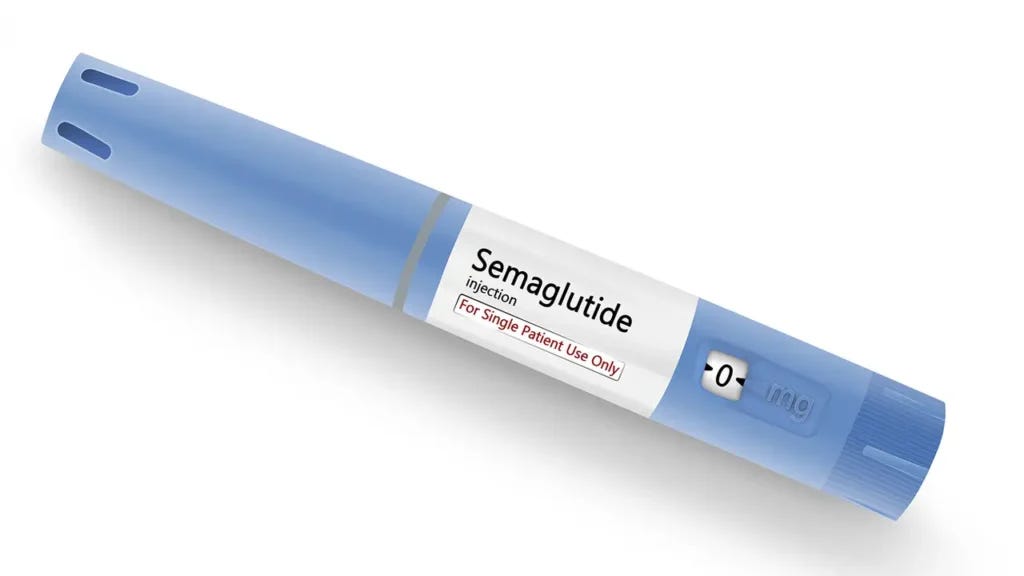What if I told you that the story of the most talked-about weight-loss drug of our time didn't begin with a quest for a slimmer waistline? What if it started, instead, with a pig's pancreas, a curious Danish scientist, and a hidden message within a gene? This is the story of Ozempic, and like all truly interesting stories, it's far more complex, and far more paradoxical, than it first appears. But behind the scientific curiosity lies another powerful force, one that shapes which discoveries make it out of the lab and into our lives.
We tend to romanticize drug development, picturing dedicated scientists toiling away in labs, solely motivated by the pursuit of cures. But the reality is far more pragmatic. Pharmaceutical companies are, after all, businesses. They are driven by profit, by the need to identify and capitalize on market opportunities. And in the late 20th and early 21st centuries, few markets were as promising as the growing epidemic of type 2 diabetes.
The groundwork, of course, was laid by genuine scientific inquiry. Before anyone could even conceive of a drug like Ozempic, scientists needed to understand the body's fundamental energy management system. Imagine your body runs on fuel, like a car. The primary fuel is sugar, specifically a type called glucose, which circulates in your bloodstream. But just like a car's engine, your body needs the right amount of fuel – not too much, not too little. Keeping this blood sugar level balanced is absolutely critical for everything from basic cell function to thinking clearly.
In the 1970s, scientists studying how the body managed this delicate fuel balance were largely focused on two key players, two hormones produced by the pancreas that act like opposing forces – the "yin and yang" of blood sugar control. These were insulin and glucagon.
Think of insulin as the body's "storage manager" or a "gatekeeper." When you eat food, especially carbohydrates, your blood sugar levels naturally rise as the glucose from your meal enters your bloodstream. This rise signals the pancreas to release insulin. Insulin's main job is to help move that sugar out of the bloodstream and into your body's cells (like muscle cells or fat cells). It acts like a key, unlocking the doors of these cells so they can take in the glucose, either to use it for immediate energy or to store it away for later use. The overall effect of insulin is to lower blood sugar levels after they've risen.
Now, consider glucagon. It's the counterpart, the "release manager." What happens when your blood sugar levels start to dip too low, perhaps because you haven't eaten for a while or you've been exercising vigorously? Your body needs to bring those levels back up to ensure your brain and other organs have enough fuel. This drop in blood sugar signals the pancreas to release glucagon. Glucagon primarily travels to the liver, which acts like the body's sugar reserve tank. It tells the liver to break down its stored sugar (called glycogen) and release it back into the bloodstream. The overall effect of glucagon is to raise blood sugar levels when they're too low.
So, you have this constant interplay - insulin working to lower high blood sugar by promoting storage, and glucagon working to raise low blood sugar by promoting release from storage. It's a finely tuned biological thermostat, constantly making adjustments to keep blood sugar within a healthy range.
Understanding this fundamental insulin-glucagon dance was the bedrock of endocrinology at the time. Researchers were deeply invested in figuring out exactly how these hormones worked, what controlled their release, and what went wrong in diseases like diabetes, where this delicate balance is disrupted (often involving problems with insulin production or the body's response to it). But in Copenhagen, a scientist named Jens Juul Holst was pursuing a slightly different path. He was fascinated by the gut, that messy, complex, and often overlooked organ system. He was studying glucagon, yes, but he was also intrigued by the other signals emanating from the digestive tract, the subtle hormonal whispers that occur after a meal. Working with pig intestines – a surprisingly useful model for human physiology – he began to find compelling evidence that the gut itself released potent substances capable of stimulating insulin secretion.
Meanwhile, across the Atlantic, at Massachusetts General Hospital, Joel Habener was immersed in the rapidly evolving world of molecular biology. He wasn't thinking about pig guts; he was thinking about genes. His lab was at the cutting edge of recombinant DNA technology, the revolutionary technique that allowed scientists to decipher the very code of life. Habener's focus was the glucagon gene, the blueprint for the hormone that raises blood sugar. And it was here, in the seemingly esoteric realm of gene sequencing, that the first hint of the Ozempic revolution emerged.
Imagine you're decoding a message, a long string of genetic letters. You expect to find instructions for one thing, glucagon. But then, buried within that message, you discover something else entirely – a hidden passage, a sequence coding for a different peptide, a molecule that would come to be known as glucagon-like peptide-1, or GLP-1. It was a classic case of scientific serendipity, a discovery lurking in plain sight.
Enter Daniel J. Drucker, a young Canadian endocrinologist who joined Habener's lab as a research fellow. Drucker brought a crucial element to the equation: a clinician's understanding of the human body, specifically the challenges faced by people with diabetes. He looked at the newly discovered gene sequence not just as a biologist, but as a doctor. While glucagon, derived from the same precursor gene, was well-known, its function was clear: it raises blood sugar by stimulating the liver to release glucose. For patients already struggling with pathologically high blood sugar – the hallmark of diabetes – adding more glucagon or enhancing its effect would generally be counterproductive, potentially worsening the very problem doctors were trying to solve. It would be like pouring fuel on an already burning fire.
But Drucker recognized that the other peptide hidden in that gene sequence, GLP-1, did something different, something potentially revolutionary. Early indications suggested GLP-1 stimulated insulin release (helping to lower blood sugar) and, crucially, also suppressed glucagon secretion (preventing blood sugar from going even higher). This dual action – boosting the hormone that lowers blood sugar while inhibiting the one that raises it – looked incredibly promising. He saw that GLP-1, unlike its glucagon cousin whose primary action would exacerbate hyperglycemia, held genuine therapeutic potential; it might actually help people manage their diabetes by addressing the core issue of elevated blood glucose.
The pieces of the puzzle began to fall into place when Holst, still diligently working in his Copenhagen lab, isolated a peptide from gut extracts that powerfully stimulated insulin release. When the sequence of GLP-1, derived from Habener and Drucker's gene cloning work, became available, the connection was made. It was a match. The peptide Holst had isolated was GLP-1. The biological activity observed in the lab corresponded perfectly with the genetic blueprint. It was one of those rare "Eureka!" moments in science, a convergence of independent lines of inquiry that suddenly illuminated a new path forward.
The early 1990s brought further confirmation. Michael Nauck, working with Holst, demonstrated the remarkable effect of GLP-1 infusion in people with type 2 diabetes: it normalized their blood sugar levels. But – and in science, there's almost always a "but" – there was a catch. A significant, frustrating, and ultimately transformative catch. Natural GLP-1, you see, was a bit like a fleeting whisper in a hurricane. It worked beautifully, when it was present. The problem was, it wasn't present for very long.
Imagine a perfectly crafted key, capable of unlocking the door to balanced blood sugar. Now imagine that key dissolving into dust mere minutes after you've crafted it. That was the challenge with natural GLP-1. Its half-life in the bloodstream – the time it takes for half of the substance to be eliminated – was tragically short, a matter of mere minutes. This rapid degradation was due to an enzyme called dipeptidyl peptidase-4 (DPP-4), a kind of molecular Pac-Man, constantly patrolling the bloodstream and gobbling up GLP-1.
But why would the body possess such an efficient destroyer for a seemingly beneficial hormone? It appears counterintuitive, almost like sabotage. The answer lies in the critical need for precise control over powerful biological signals. GLP-1's effects – stimulating insulin, suppressing glucagon, slowing digestion – are profoundly useful immediately after a meal when nutrients are flooding the system. However, if that signal persisted for hours, long after digestion is complete, it could potentially drive blood sugar dangerously low (hypoglycemia).
DPP-4 acts as the body's crucial "off switch" for GLP-1 and other related hormones (like GIP). It ensures that the potent effects of these glucose control hormones are tightly linked to the presence of food, rising quickly after eating and fading rapidly once their job is done. It's a system designed for rapid response and equally rapid termination, maintaining metabolic balance. So, while absolutely essential for the body's minute-to-minute fine-tuning, this highly efficient DPP-4 enzyme became the central villain – and the primary target for modification – in the quest to turn GLP-1 into a viable therapeutic agent.
To achieve a therapeutic effect, you'd need to continuously infuse GLP-1, a scenario utterly impractical for everyday life. Imagine being tethered to an IV drip, just to maintain stable blood sugar. It's the antithesis of a convenient, patient-friendly treatment. This rapid breakdown wasn't just an inconvenience; it was a fundamental roadblock.
But the short half-life wasn't the only hurdle. Natural GLP-1, when administered in the quantities needed to try and overcome its rapid degradation, also came with a rather unpleasant entourage of side effects. The most prominent of these was nausea, often accompanied by vomiting. Think about it: a drug that's supposed to help you manage a chronic condition, but makes you feel constantly queasy. It's a classic Catch-22, because the very mechanisms that made GLP-1 effective – its action on the gut and the brain – also triggered these undesirable effects, especially at the higher, sustained levels needed to compensate for its rapid breakdown.
Specifically, this nausea stemmed from GLP-1's dual impact. First, it significantly slows down gastric emptying, causing food to linger in the stomach. This delay leads to uncomfortable fullness and bloating, sending potent nausea signals to the brain. Second, GLP-1 directly activates receptors in key brain areas known to control appetite, satiety, and nausea itself (including the hypothalamus and the area postrema, often called the brain's 'vomiting center'). Thus, the queasiness was a direct result of GLP-1 simultaneously telling the stomach to brake hard and signaling the brain about extreme fullness, bordering on aversion.
It wasn't just a mild discomfort, either. For some patients receiving infusions of natural GLP-1, the nausea was severe enough to make the treatment unbearable. This wasn't a minor detail; it was a major impediment to its widespread use. A drug that makes you feel worse than the disease it's supposed to treat is hardly a therapeutic triumph.
The crucial realization wasn't just that GLP-1 existed; it was that GLP-1 could be monetized. Natural GLP-1, with its fleeting lifespan and unpleasant side effects, was commercially useless. It was like discovering a vein of gold deep underground, but with no practical way to extract it.
This need, the necessity of making GLP-1 therapeutically viable, sparked the search for an analogue, a molecular mimic that could retain the benefits of GLP-1 while sidestepping its flaws. Enter Novo Nordisk, a company with a long history in diabetes care, and a keen eye for market trends. They were driven by the opportunity to develop a blockbuster drug, a medication that could generate billions of dollars in revenue.
The Novo Nordisk team led by Lotte Bjerre Knudsen embarked on a painstaking process of molecular engineering, tweaking the structure of GLP-1, searching for a version that could resist the enzymatic onslaught of DPP-4 and offer a more sustained effect.
The challenge, and the potential reward, was immense. Type 2 diabetes was becoming a global pandemic, driven by rising rates of obesity in turn caused by massive overconsumption of sugar. Since no-one was reducing sugar consumption anytime soon, a drug that could effectively control blood sugar, with a convenient dosing regimen, represented a vast, untapped market.
The limitations of natural GLP-1 – its rapid degradation and side effects – weren't seen as insurmountable obstacles; they were seen as engineering problems to be solved. And Novo Nordisk, like other pharmaceutical companies, was in the business of solving engineering problems, particularly when the potential return on investment was so high.
Their efforts culminated in liraglutide, a landmark achievement. Liraglutide was a modified version of GLP-1, with a crucial addition: a fatty acid chain. Think of it like adding a protective shield to our fragile key, making it far less susceptible to being broken down. This seemingly small change had a profound impact. Liraglutide's half-life was extended to around 13 hours, a vast improvement over the fleeting minutes of natural GLP-1. This meant that instead of a continuous infusion, patients could manage their diabetes with a once-daily injection. It was a major step forward in terms of convenience and practicality.
Lotte Bjerre Knudsen and her team weren't simply exploring the wonders of peptide chemistry, they were designing a product. Liraglutide, with its fatty acid chain modification, wasn't just a scientific achievement; it was a marketable improvement. The once-daily injection, compared to the impracticality of natural GLP-1, was a key selling point, a feature designed to appeal to both patients and physicians.
Liraglutide (Victoza) was a commercial success, validating the GLP-1 receptor agonist approach. But even as Victoza was generating substantial revenue, Novo Nordisk was already looking ahead. The market, they understood, wasn't static. Patients, and their insurers, were always looking for better, more convenient options. A once-daily injection was good; a once-weekly injection would be even better.
Moreover, while liraglutide was generally well-tolerated, some patients still experienced side effects, particularly nausea, especially at the beginning of treatment. While less severe than with natural GLP-1, it was still a factor that could limit adherence to the medication. The ideal scenario would be a drug that not only worked effectively but also minimized the risk of unpleasant side effects.
The answer, once again, lay in clever molecular engineering. Building upon the foundation laid by liraglutide, they further modified the GLP-1 molecule. The key, it turned out, was to refine the fatty acid attachment and introduce some subtle changes to the amino acid sequence. These modifications, seemingly minor on paper, had a dramatic effect. They further enhanced the molecule's resistance to degradation by DPP-4, and, crucially, they significantly increased its ability to bind strongly to albumin.
Albumin is the most abundant protein in our blood plasma; it's a large, bulky molecule that functions, in part, as a transport vehicle for many smaller molecules. Now, consider how the kidneys filter blood: they act like a sieve, allowing small waste products and excess substances to pass through into the urine, while retaining large, essential components like proteins within the bloodstream. A relatively small molecule like a GLP-1 analogue, left to its own devices, would be much more susceptible to being filtered out by the kidneys over time.
By engineering semaglutide to bind tightly to the massive albumin molecule, the scientists essentially created a combined entity that was too large to easily slip through the kidney's filtration system. Imagine a small package (semaglutide) being securely strapped to a large delivery truck (albumin). The truck is too big to exit via the small side roads (kidney filtration pores), so the package stays in the main circulation as long as it remains attached to the truck. This binding isn't permanent; semaglutide can slowly detach, allowing it to interact with GLP-1 receptors, but while bound, it's protected from rapid renal clearance. This process effectively creates a reservoir of the drug in the bloodstream, dramatically slowing its elimination from the body. This clever mechanism of leveraging albumin binding to avoid kidney filtration was the key innovation behind semaglutide's remarkably long half-life of approximately one week.
The result of this molecular tinkering was semaglutide, a GLP-1 receptor agonist with a half-life of approximately one week. That's a staggering leap from the minutes of natural GLP-1 and the 13 hours of liraglutide. Suddenly, the daily injection was replaced by a weekly one. It was a paradigm shift in the treatment of type 2 diabetes.
The development of semaglutide wasn't simply a quest for scientific perfection; it was a strategic move to maintain market dominance. The further refinements to the GLP-1 molecule, the enhanced albumin binding, the extended half-life – these were all driven by the desire to create a superior product, a drug that could outcompete existing therapies and capture an even larger share of the lucrative diabetes market.
And then came the unexpected twist, or perhaps an amplification beyond initial expectations: the "Ozempic effect," a constellation of outcomes observed with semaglutide that transcended the drug's initial focus on diabetes treatment. While the connection between GLP-1 and appetite regulation was known science, the sheer magnitude and consistency of the weight loss observed in patients taking semaglutide during clinical trials was striking. People weren't just losing a few kilograms; studies were showing average weight loss often reaching 10-15% or even more of their starting body weight over time – figures significantly higher than seen with most previous anti-obesity medications.
But the "Ozempic effect" wasn't just a number on a scale; it encompassed profound changes reported by users regarding their relationship with food. Beyond simple appetite suppression, many described a dramatic quieting of constant thoughts about food (often referred to as "food noise"), feeling satisfied with much smaller portions, experiencing a marked reduction in cravings, and simply losing interest in eating when not truly hungry. This powerful impact on appetite and satiety, combined with the drug's foundational benefit of robust blood sugar control (in those with diabetes) and, as later studies confirmed, significant cardiovascular benefits for certain patient groups, created a compelling and multifaceted therapeutic profile.
It was this potent combination – particularly the dramatic, visible weight loss coupled with the compelling narrative around reduced "food noise" – that captured the public imagination. Fueled by social media testimonials (before-and-after pictures, personal accounts), celebrity whispers (both confirmed and rumoured), and ensuing widespread media coverage, the "Ozempic effect" became shorthand for rapid, seemingly effortless transformation. This intense cultural buzz propelled semaglutide beyond its initial medical indications, opening up the vast and lucrative market of obesity treatment. The higher-dose formulation, Wegovy, specifically approved for weight management, directly tapped into this enormous market – one driven not only by clinical need but also by powerful societal pressures, pervasive body image ideals, and the ever-present desire for a perceived quick fix. Consequently, semaglutide transformed from simply a successful diabetes drug into a global cultural phenomenon, sparking widespread, ongoing debate about its use, cost, equitable access, and broader societal impact.
Imagine finding yourself in a boat that has sprung several leaks (the root causes of metabolic disease, sugar and seed oils). Fortunately, you're given a powerful, automated pump (Ozempic) that effortlessly keeps the water level down (manages weight/blood sugar). The boat sails smoothly, the immediate crisis averted. Everyone celebrates the efficiency of the pump. But what if the celebration distracts us from asking why the boat is leaking in the first place, or noticing we're sailing straight into a storm? This is the question hovering around the remarkable rise of Ozempic and its siblings.
The journey of semaglutide, from painstaking laboratory science involving gut hormones to a cultural touchstone reshaping bodies and conversations worldwide, is undeniably compelling. It works. Often, it works dramatically, quieting the relentless "food noise" in people's heads, helping kilos melt away, bringing blood sugar under control in ways previously requiring far more effort or risk. It feels like a win, a decisive victory against stubborn biological forces.
But here's the paradox. Could its very effectiveness be its subtlest danger? Is Ozempic becoming the exquisitely engineered patch that allows us to ignore the crumbling foundations of our metabolic health? The widespread epidemics of type 2 diabetes and obesity didn't appear out of thin air. They grew out of an environment – a food system saturated with sugar and seed oils. Are we embracing a powerful tool because it spares us the daunting task of fixing the food environment?
Look what happens when the drug stops. The numbers often creep back. The "food noise" returns. The body, freed from the drug's influence, simply snaps back to the state dictated by its surroundings and underlying programming. The magic trick is revealed; the rabbit reappears. Taking Ozempic, then, seems akin to running a highly efficient pump in a boat with persistent leaks. The pump (Ozempic) does an excellent job of keeping the water level down, allowing the boat to function well. But it doesn't patch the holes. Stop the pump, and the boat inevitably starts filling with water again. This highlights that Ozempic acts as a masterful, ongoing management strategy, rather than a cure that addresses the fundamental leaks.
And that strategy points towards lifelong use for many. The implications branch out: the staggering cost, the questions about long-term effects decades down the line. But there's a deeper biological question, too. What does it mean to pharmacologically manage weight and blood sugar while continuing behaviours, like high sugar and seed oil consumption, that fueled the problem? Ozempic might lower A1c and reduce weight, but does it neutralize all the other, less visible effects of that sugar and seed oil – the low-grade inflammation, the stress on cellular machinery, the unseen metabolic consequences like fatty liver disease, kidney disease, gout, hypertension and heart disease that don't show up on the scale? It’s unlikely. Are we, in effect, silencing the body's most obvious warning signals while letting subtler alarms continue unheard?
This is the complex bargain presented by the Ozempic era. It's a stunning piece of biochemical engineering, offering real relief and control to individuals facing significant health challenges. But it also acts as a mirror, reflecting our societal choices. Are we opting for a sophisticated and potentially lifelong medical intervention because it feels easier than confronting the deeply embedded environmental and systemic factors driving our metabolic health crisis? Ozempic didn't create that crisis, but its triumphant arrival forces us to ask whether we're using it to truly solve the problem, or just to manage its most visible symptoms while the storm rages on.









My GP recommended this to me and it did suppress appetite I did lose some initial weight most likely due to the reduced calories. The negative effects were loss of muscle mass and lethargy. I dropped it a few months ago and am focusing on less sugar more exercise and my weight is stable but I am getting the muscle definition back. I’m over 60 so I’m going to focus on reducing sugar and increasing my exercise.
Great explanation. Easy to understand. A thought producing artical about an easy fix for the rich….